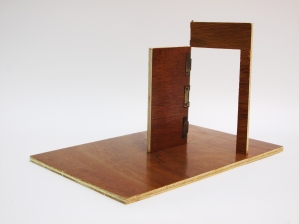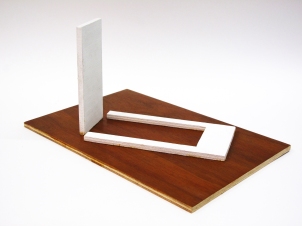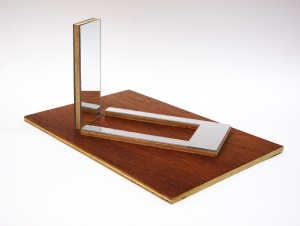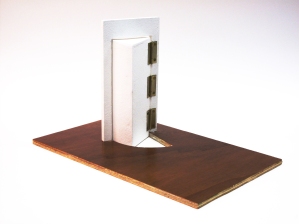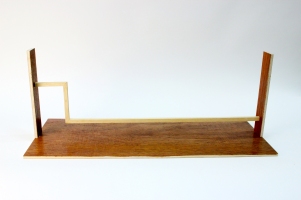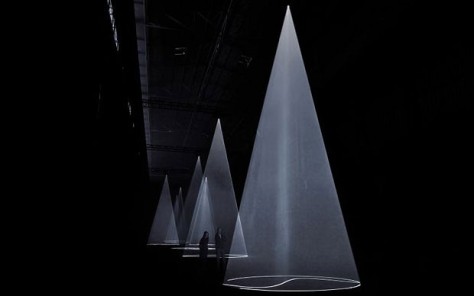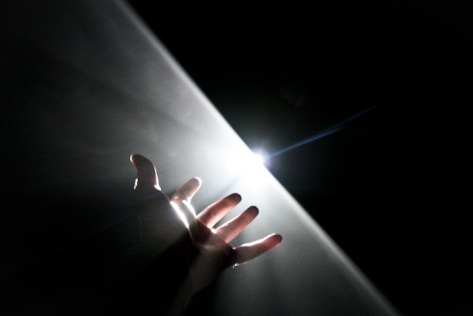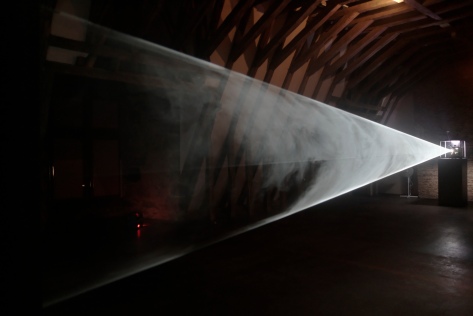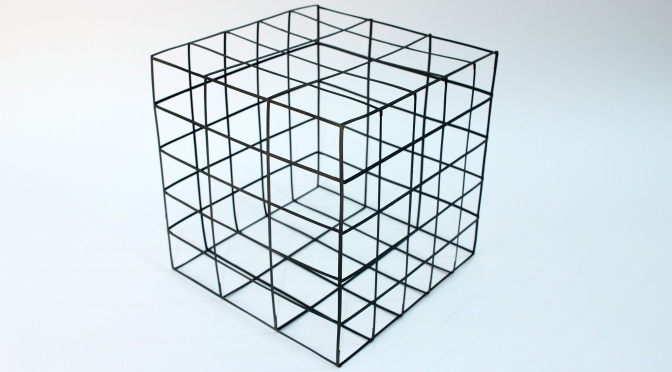An interlude to all my history of art, I bring to you Cardboard Carpentry. Inspired by my travels to清境 (pronounced qing1 jingo), Taiwan, I have attempted to take cardboard to another level but try to make it into furniture like those I have seen in the Carton King. These pieces are works-in-progress and are far from completion. Whatever you see below has been made purely from “recycled” cardboard boxes of televisions, washing machines, etc.
THE MOTIVE & INSPIRATION
Rather simple – to find other uses for cardboard beyond the circular process of making more boxes or for purely aesthetic ones such a scrapbooking or mounting images on a surface. As mentioned earlier, the tables, chairs, bags, games, etc from Carton King, 清境 got me thinking about the potential for the material. It is almost an everyday material – your bulky packages arrive in them and electronics are encased in huge ones amongst so many other things. I am not saying that we do not recycle them enough or more efficiently than when I create them, but rather I hope that this is an alternative that could get others going on the potential of it.
I wanted to stretch the material even further and try experimenting for myself with it. I asked myself if someone else could do all that with the help of machinery, could I do it without, and if so, what would I make and how would I make it? As I mentioned in the post, 清境, I highly doubt that the cardboard used at Carton King came from recycled boxes simply do to the sheer volume of cardboard necessary to make all the goods for sale. In addition, the process of making all these goods are not only labor intensive, but also demand clean, unadulterated cardboard for a sellable finish.
THE MATERIAL
At its most basic form, it is essentially paper (or most times recycled paper) that has been treated to withstand handling, wear and tear, etc. Some have been treated to the extent that they are waterproof on the surface or reinforced with strong adhesives and numerous layers. The standard cardboard will have a corrugated “core” that enhances it’s strength, yet allows it to maintain a relatively light mass so that it does not add unnecessary weight in addition to the object that it contains.
As can be seen in the image on the right, the corrugation is triangular in fashion, in order to give it some strength and durability. However, more often than not cardboard will end up creased along the hollow areas if bent or folded parallel to  the corrugation due to handling and it is difficult to find cardboard surfaces that are not tainted by these crease marks. It is almost impossible to obtain a clean finish if one uses cardboard as the main material of a structure. Pressure on the surface will also cause dents in the cardboard that may look aesthetically displeasing in addition to compromising the structural integrity. Over time, lines are bound to appear and the colour will almost definitely go off if not chemically treated in any way.
the corrugation due to handling and it is difficult to find cardboard surfaces that are not tainted by these crease marks. It is almost impossible to obtain a clean finish if one uses cardboard as the main material of a structure. Pressure on the surface will also cause dents in the cardboard that may look aesthetically displeasing in addition to compromising the structural integrity. Over time, lines are bound to appear and the colour will almost definitely go off if not chemically treated in any way.
Furthermore, this material is susceptible to the elements, rarely lasting a day in inclement weather. In the rain, watermarks will appear in blotches like mould on bread and eventually the card will go soft and lose all structural integrity rending it useless in nearly all circumstances, especially its purpose to protect and contain items. (Do not get me wrong though. Soggy, drenched cardboard still has many uses. However, I was and currently am attempting to keep the material in the condition that I received it in.)
That being said, it is recyclable, biodegradable and in most circumstances environmentally friendly if recycling remains a self-sustaining cycle, easily being broken down and remade into its former self. But, I highly doubt that is the case.
THE PROCESS
As much as it may be hard to believe, the process was rather straight forward. My process of making the chair was an immediate transition from conceptualization to realization. I was determined to not sketchout my plans, dimensions, etc. but immediately start constructing the chair on the spot. This “spur of the moment” methodology is something that I have grown up with and continued to hone after all these years, constantly thinking three-dimensionally rather 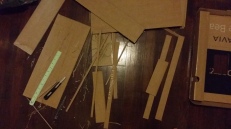 than going through the intermediate two-dimensional process of sketches and written words. Personally, I find that this process demands a lot of forward thinking as well as instantaneous problem solving. When a problem comes up during my process, I will have to immediately troubleshoot in order to not ruin the flow of creating the piece. I have applied this process to many of my works which includes majority of International Baccalaureate submissions revolving around the theme of Space. I understand that stating this becomes a matter of trust, as you readers and audiences truly do not know if I actually sketched out any part of my process or not.
than going through the intermediate two-dimensional process of sketches and written words. Personally, I find that this process demands a lot of forward thinking as well as instantaneous problem solving. When a problem comes up during my process, I will have to immediately troubleshoot in order to not ruin the flow of creating the piece. I have applied this process to many of my works which includes majority of International Baccalaureate submissions revolving around the theme of Space. I understand that stating this becomes a matter of trust, as you readers and audiences truly do not know if I actually sketched out any part of my process or not.
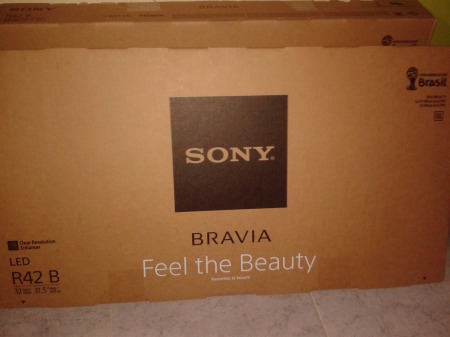
Moving on from the transitionary phase between conceptualization and actually manifesting the product, I contemplated the design and aesthetic look of the piece. At the start, in my mind’s eye, the chair was to be a simple one. It would have a square base of which three sides would act as “legs” or main support of the chair and last would remain unsupported. In addition, there would also be an armrest and a backrest. Overall, It would be asymmetrical in nature.
With that in mind, I started to take measurements from other chairs and used them as references when determining the height of my construct. The cardboard box, which originally contained a SONY Bravia television (Image above), was then divided cut up into separate segments using the fold lines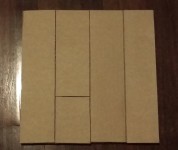 as guides. The largest area were then divided into three segments which would then become the three sided support of the chair. The unused cardboard was set aside to increase the strength and durability of these supports. The seat area (image on the right) was cut from the other large surface of the box and reinforced with corrugated cardboard that was meant to protect the television from any impact.
as guides. The largest area were then divided into three segments which would then become the three sided support of the chair. The unused cardboard was set aside to increase the strength and durability of these supports. The seat area (image on the right) was cut from the other large surface of the box and reinforced with corrugated cardboard that was meant to protect the television from any impact.
After making a hell of a mess in my room, I ended up with the basic components to create the form of my chair (Image below).
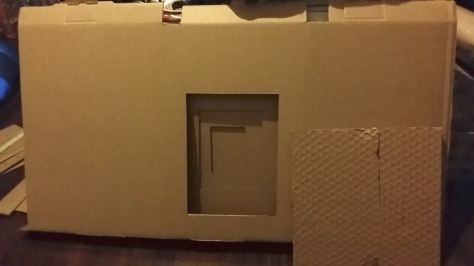
As I imagined it in my head, the chair would not be that aesthetically appealing other than the fact that it was made purely out of cardboard and glue. So in the moment, I made the decision to cut out fame-like shapes at the sides as can be seen in the image above. This simple design was sparked by old Chinese chair 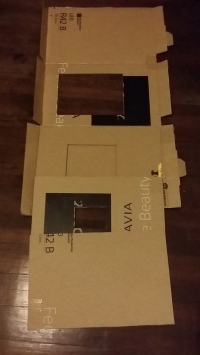 designs (usually cylindrical), where the center of the support would be cut out and a rectangular frame would be left. I believed that that design was simple yet sophisticated enough to catch the eye yet retain the structural strength to support a man’s weight. To enhance the strength of the chair, I made layers of these frames, which unknowingly added some depth to the side of the chair and enhance the aesthetics of the chair further. Keeping with the asymmetrical theme of this particular project, I decided that not all side will have the same concept of depth, with each side being layered with a different number of cardboard sheets. The finished components can be seen in the picture on the right.
designs (usually cylindrical), where the center of the support would be cut out and a rectangular frame would be left. I believed that that design was simple yet sophisticated enough to catch the eye yet retain the structural strength to support a man’s weight. To enhance the strength of the chair, I made layers of these frames, which unknowingly added some depth to the side of the chair and enhance the aesthetics of the chair further. Keeping with the asymmetrical theme of this particular project, I decided that not all side will have the same concept of depth, with each side being layered with a different number of cardboard sheets. The finished components can be seen in the picture on the right.
In addition to all these “flourishes”, I continually pondered over how I could enhance the strength of this chair, which led me to reinforce the area where most chair legs would be. Making a huge mess, I cut up long, wide strips of cardboard from various other recycled boxes to form square pillared legs for the chair and, after gluing them on, am in the midst of tidying up their aesthetic look but pasting on unmarked strips of cardboard. Due to the small surface area of the contact point between the leg segment and the maid body of the chair, I decided to use epoxy to ensure that the legs remain fast to the main frame. The end product can be seen below.
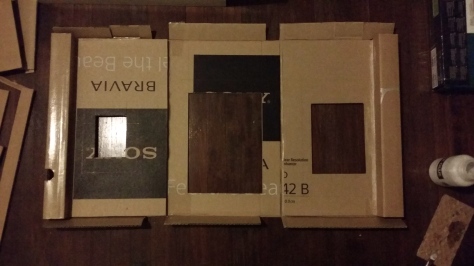
As an intermission and with a strong desire to finish “something” and hold it in my hands, I made another small footstool out of the leftover cardboard. This simple stool was made out of numerous layer of cardboard with detachable legs. 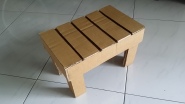 Being compact, it also it durable, easily support heavy weights.You can see it from the images on the right. From the top view, you can also see how cardboard is prone to creases and folds. Nevertheless, I believe that it is a project that anyone can undertake and should try at least once if there is any leftover cardboard lying around the house.
Being compact, it also it durable, easily support heavy weights.You can see it from the images on the right. From the top view, you can also see how cardboard is prone to creases and folds. Nevertheless, I believe that it is a project that anyone can undertake and should try at least once if there is any leftover cardboard lying around the house.
References:
The Carton King (thewanone post)
The Carton King (Website)
Cardboard (Wikipedia)

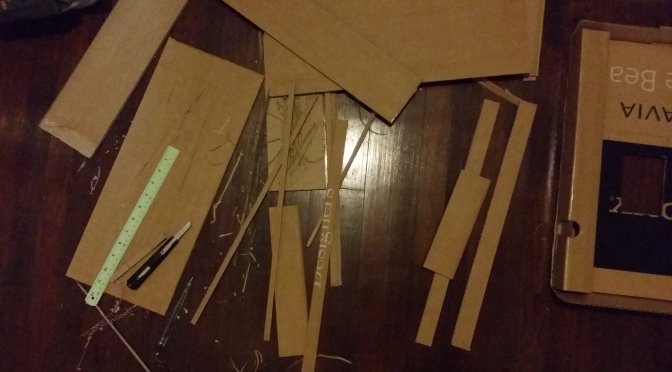
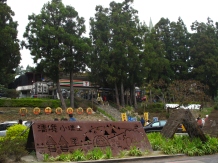
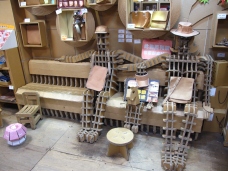
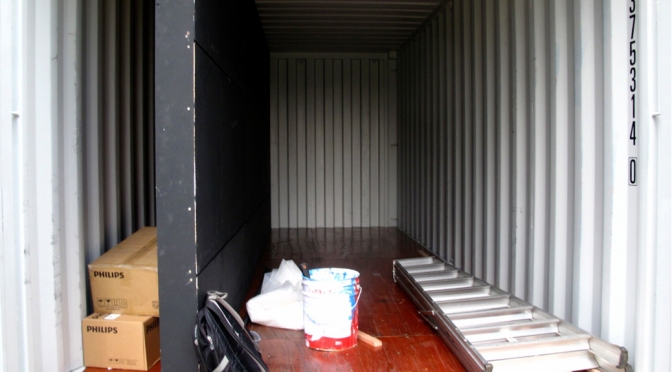
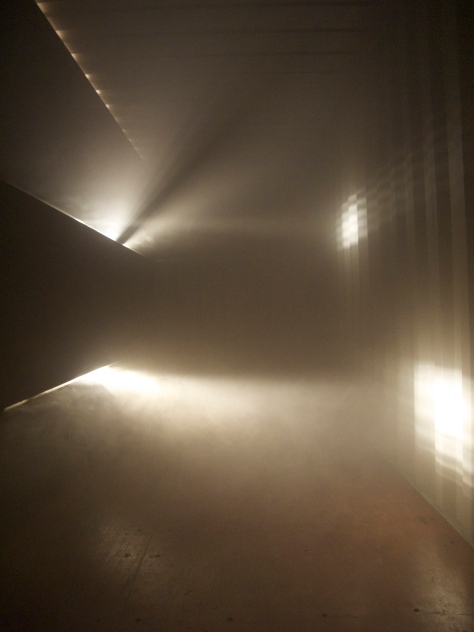
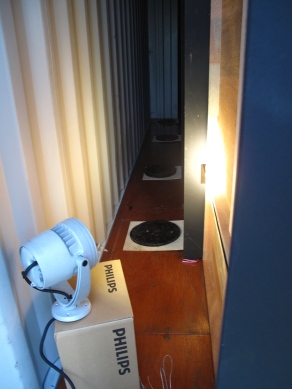
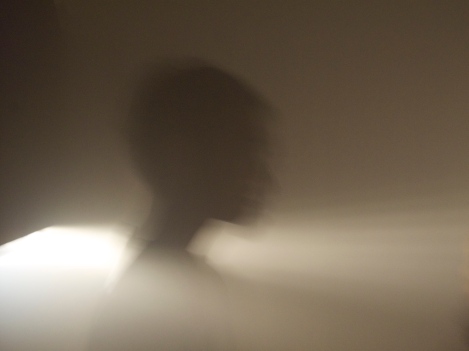
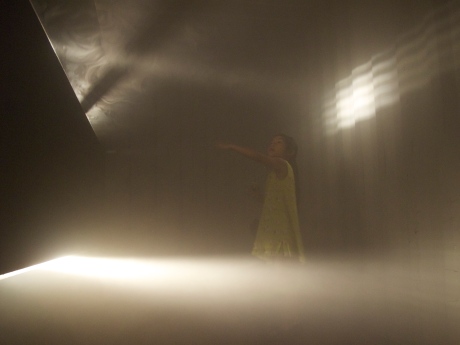
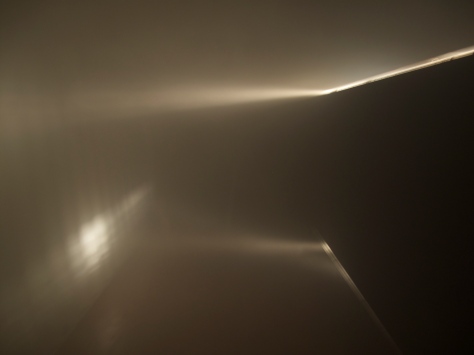
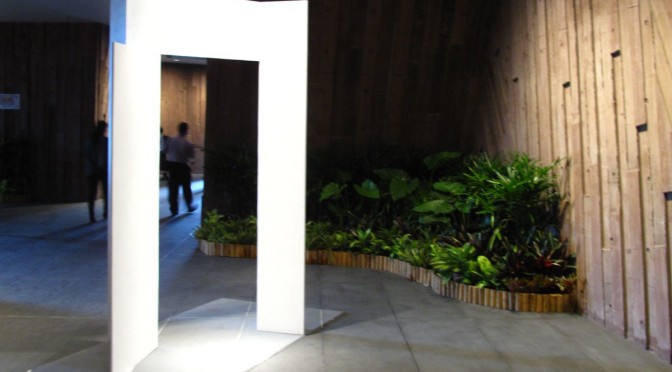

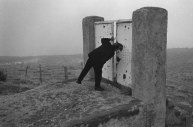 on the side. However, we recognise the walls that lay right there in front of our eyes, but often neglect the entrance into that space. This consideration made me question – how do we view doors? a transitioning point into another space or a mere object barring the way and obstructing movement between spaces?
on the side. However, we recognise the walls that lay right there in front of our eyes, but often neglect the entrance into that space. This consideration made me question – how do we view doors? a transitioning point into another space or a mere object barring the way and obstructing movement between spaces?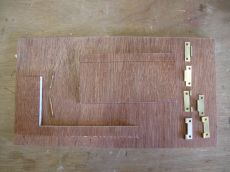 the door itself, and attempting to recreate all these components myself form the raw materials I had on hand in the studios.This process saw me buying all the different variations of hinges that I could get my hands on, garden gate hinges, typical door hinges, even “manufacturing” my own hinges varying in size and material to really feel how each part of a door contributed to the entire system that we see in every room. In going through this process, I discovered the process of art making, handling and feeling the material, to stretch it to its limits and push it further than I have ever done before.
the door itself, and attempting to recreate all these components myself form the raw materials I had on hand in the studios.This process saw me buying all the different variations of hinges that I could get my hands on, garden gate hinges, typical door hinges, even “manufacturing” my own hinges varying in size and material to really feel how each part of a door contributed to the entire system that we see in every room. In going through this process, I discovered the process of art making, handling and feeling the material, to stretch it to its limits and push it further than I have ever done before. 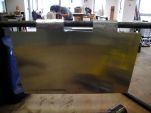 I would flatten, hammer, even soften aluminium just to create my own hinges. In that rigorous, laborious journey, I found satisfaction in simply “making”, and it gave me such great joy to just appreciate the final product and know that I saw
I would flatten, hammer, even soften aluminium just to create my own hinges. In that rigorous, laborious journey, I found satisfaction in simply “making”, and it gave me such great joy to just appreciate the final product and know that I saw 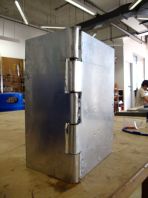 the process from beginning to end. The simple realization that I was actually creating the door from scratch made me reflect deeply on the art making journey that all artist embark on. That, as artists, each component, whether it be a brushstroke or a single nook made by a chisel, matters greatly in the grand scheme of things. it is an initial step in to the creation of an entire system that
the process from beginning to end. The simple realization that I was actually creating the door from scratch made me reflect deeply on the art making journey that all artist embark on. That, as artists, each component, whether it be a brushstroke or a single nook made by a chisel, matters greatly in the grand scheme of things. it is an initial step in to the creation of an entire system that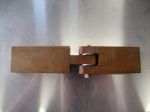 allows a work to become whole and, ultimately, convey what the artist’s soul want to share with his audiences, to challenge norms and draw viewers out of their comfort zone.
allows a work to become whole and, ultimately, convey what the artist’s soul want to share with his audiences, to challenge norms and draw viewers out of their comfort zone.